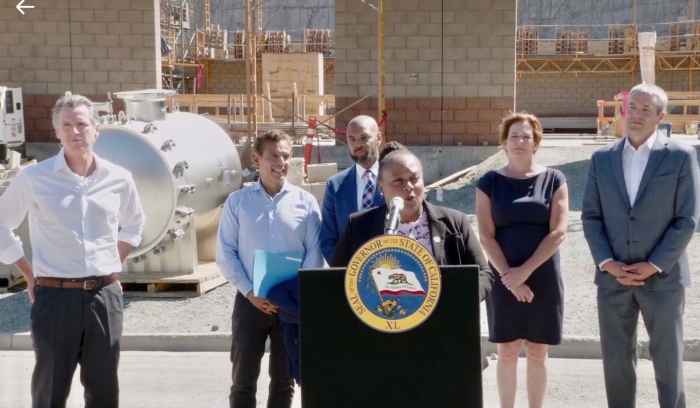
The Golden State is doing more than just praying for rain amidst the historic drought that is battering the state and the western United States.
Gov. Gavin Newsom unveiled a plan that would increase California’s water supply and combat the extreme weather patterns caused by climate change. The initiative, its scope captured in the 19-page “California’s Water Supply Strategy, Adapting to a Hotter, Drier Future” document released by Newsom’s administration, will invest $8 billion in water recycling, storage, and desalination.
The plan, Newsom said, is in response to a deeper understanding of how dire California’s water crisis is.
“The hydrology in the state has begun to change pretty significantly,” he said. “The aridification that we are experiencing leads us now, the science and data leads us now, to understand we will lose 10 % of our water supply by 2040.”
The governor made his remarks at an Aug. 11 press conference held in front of the $110 million Antioch Brackish Desalination Project facility, currently under construction at the city of Antioch’s wastewater treatment plant. When completed within the next two years. the first surface-water desalination plant in the Bay Area will use large reverse-osmosis filters to create six million gallons of fresh water per day.
Antioch mayor Lamar Thorpe said the facility is one of the innovative solutions Californians need to in response to climate change and the current drought, which began in 2020.
Assemblymember Lori Wison (D – Suisun) said, “We are experiencing the worst drought the Western United States has seen in 1,200 years. We must find innovative solutions to climate challenges like this if we are to move forward successfully…… Under the Governor’s leadership, California is investing in technology, solutions, and people to build a more resilient, even as California leads the charge to combat climate change.”
Newsom said constructions like Antioch project are part of the plan.
“We are focused on creating more supply. We are focused on creating more water,” he said. “We need to be more creative and more aggressive in not just promoting this technology but delivering on its promise and more over its potential.”
The “Water Supply Strategy” includes creating storage space for up to four million acre-feet of water, so that rain water from big storms can be captured and stored for dry periods and recycling and reusing at a minimum 800,000 acre-feet of water per year by 2030, reducing wastewater discharged to the ocean. Employing more efficient water conservation the state will free up 500,000 acre-feet of water to make up for water lost because of climate change. Additionally, new water captured by stormwater and desalinating ocean water and salty water in groundwater basins will be available for use.
Officials across the state applauded plan.
San Diego County Water Authority General Manager Sandra L. Kerl said the “Water Supply Strategy” is an important step to protect California’s economy and quality of life.
“The governor’s approach aligns closely with the Water Authority’s 30-year strategy that combines new supplies, infrastructure upgrades, and conservation,” she said.
There were some that disagreed with some of Newsom’s plan.
Kate Poole, senior director of the Natural Resources Defense Council’s nature program, told the LA Times some of the initiative was good.
Poole said, “It’s really the things that aren’t in there that are most concerning,” she said. “Agriculture obviously uses 80 percent of our developed water supply in California. So you can’t really deal effectively with water use without dealing with Big Ag. And Newsom does not seem very willing to do that.”
California is experiencing its second drought in the last decade. The sense of urgency is real, said Newsom.
“The hots are getting a lot hotter and the dries are getting a lot drier,” he said. “We have to adapt.”






